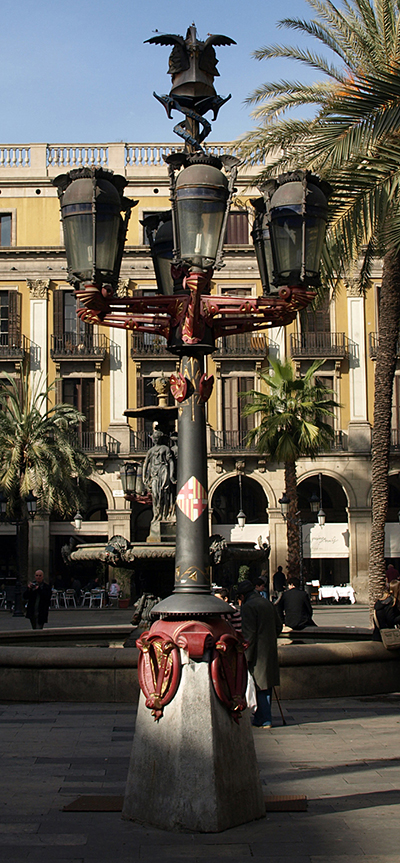The extraordinary lampposts standing in La Place Royale, a large open square in Barcelona's centre, display the artistic talent of the Catalan architect, Antoni Gaudi. Colourful, ornate and highly symbolic, the two lampposts were twenty-seven-year-old Gaudi's first commission.
His skills as a newly-qualified draughtsman assisting Josep Fontserè i Mestre create new gates for the Ciutadella Park had evidently impressed the city's council who requested the public lighting. Typically, Gaudi failed to produce a drawing relying instead on an enthusiastic letter describing his visionary plans in detail. He even predicted that the project would be completed for less than the allocated allowance of 3,605 pesetas.
Ornamental
Gaudi meticulously researched his design for the Lampadaire de la Place Royale drawing on his love of nature and history. The pedestal base of each lamp has been cut from a block of marble. Each face has chamfered, angled edges and is adorned at the upper, narrower part with wreaths of entwined flowers and ivy painted in dark red. The main post is of polished cast iron which Gaudi coated in lacquer to prevent corrosion. In the middle of the post is the Barcelona coat of arms.
Wrought Iron
At a height of two-thirds, six arms protrude at equal distances to provide supports for a ring of six lamps. Each arm is of wrought ironwork, no doubt inspired by the intricate designs Gaudi often saw his coppersmith father create. Gaudi highlighted in his letter how the supports and the accompanying flower motifs above and below would be painted dark red to prevent them casting harsh reflections in the Spanish sunshine.
Illumination
The six lamps are encased in glass surrounds which are capped with bronze domes. Around each glass lantern, connecting the top of the dome to the base of the lamp, are four bronze rods heavily embellished with various fans, scrolls and serrated ribbons. The lamps were originally powered by gas. Gaudi described his choice of white onyx for the inside of the lamps was based on the materials used for street lighting in other European cities. It was designed to cast light directly to the ground creating magnificent pools of illumination at night.
Symbolism
Gaudi used classical imagery to embellish the pinnacle of the lamppost to emphasise Barcelona's status as one of Spain's most important centres of trade. The winged helmet of the Roman deity, Mercury, the god of commerce and a friendly guide to weary travellers, is cast in bronze. Twining beneath are the two serpents that curl around Mercury's staff or caduceus.
Tourist Attraction
The success of Gaudi's Lampadaire de la Place Royale prompted Barcelona to commission another set of lamps in 1890 for the Pla de Palau. However, these lampposts had three lanterns instead of six. After Gaudi's death in 1926, his work was largely dismissed as over-bearing and fanciful. However, during the 1950s, a revival was begun by the designer, Josep Lluis Sert and the artist, Salvador Dali and continues to the present day.




